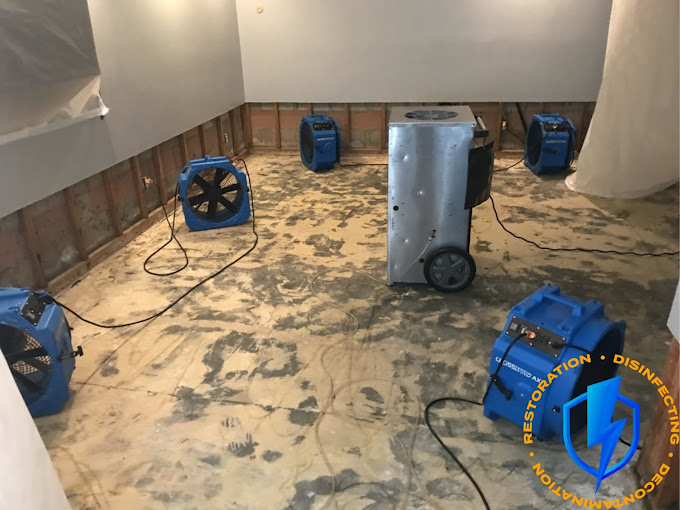Water damage restoration typically takes 3 to 7 days for the initial mitigation and drying process. Minor repairs can be completed within 1 to 3 days, while moderate damage may take 1 to 2 weeks.
Severe water damage requiring extensive rebuilding can take several weeks to months. The exact timeline depends on factors such as the severity of the damage, type of water involved, materials affected, and environmental conditions.
Keep reading to see how long your water damage restoration might take.
Factors Influencing Restoration Time
The time required to complete water damage restoration depends on several key factors. Each of these variables plays a role in determining how quickly a property can be restored to its original condition.
Severity of Water Damage
The extent of water damage significantly impacts how long the restoration process will take. Minor leaks that affect a small area require less time to address compared to major flooding incidents that impact multiple rooms or floors. Additionally, if the damage has gone unnoticed for a prolonged period, mold and structural issues may further extend the restoration timeline.
Severe water damage, particularly from contaminated water sources, requires additional steps such as disinfection, mold remediation, and potential structural repairs.
Type of Water
Water damage is categorized into three types, each affecting the restoration timeline differently:
| Water Type | Description | Impact on Restoration Time |
| Category 1 (Clean Water) | Originates from a sanitary source, such as a broken pipe or sink overflow. | Fastest to restore, typically requiring only drying and minor repairs. |
| Category 2 (Gray Water) | Contains some contaminants, such as from a washing machine or dishwasher leak. | Requires more extensive cleaning and disinfection, increasing restoration time. |
| Category 3 (Black Water) | Highly contaminated water, such as sewage backups or floodwater. | Requires thorough disinfection, removal of affected materials, and potential structural repairs, leading to the longest restoration time. |
Since black water requires specialized cleaning, the restoration process takes considerably longer compared to clean water incidents.
Materials Affected
Different materials absorb and retain water at varying rates, influencing how long they take to dry and whether they require replacement.
- Porous materials such as drywall, carpet, insulation, and fabric absorb water quickly and take longer to dry. In many cases, they must be removed and replaced to prevent mold growth.
- Non-porous materials such as tile, concrete, and metal do not absorb water as easily, allowing for faster drying and restoration.
If water damage affects drywall, carpets, and wooden flooring, additional drying time is required before repairs can begin.
Response Time
Acting quickly after water damage occurs can significantly reduce the overall restoration time. The sooner water extraction and drying begin, the less likely structural issues and mold growth will develop. If water is left to sit for more than 24-48 hours, mold can start to form, which extends the restoration timeline due to the additional remediation needed.
Environmental Conditions
Climate and indoor conditions play a crucial role in the drying process. Warm, dry conditions speed up evaporation, while cold, humid environments slow down drying. Using dehumidifiers, fans, and heaters can accelerate drying times, but in unfavorable environmental conditions, drying may take longer than expected.
Restoration Timeline
The water damage restoration process consists of several stages, each with its own estimated timeline.
Mitigation Stage (3 to 7 Days)
The first phase of water damage restoration involves water extraction and drying. During this stage, professionals:
- Extract standing water using industrial pumps.
- Remove wet materials such as carpets, drywall, and insulation if necessary.
- Set up dehumidifiers and air movers to accelerate drying.
This stage typically lasts between 3 to 7 days, depending on the extent of the water damage.
Drying Process (Around 72 Hours)
Once standing water is removed, the drying process begins. Drying typically takes around three days (72 hours) for most cases, but factors such as humidity levels and material types can impact the duration. Professionals monitor moisture levels using specialized equipment to ensure thorough drying before proceeding to repairs.
Rebuild and Repairs (Varies Based on Damage Severity)
The final phase of water damage restoration involves repairing and rebuilding affected areas. The time required for this stage depends on the severity of the damage:
| Damage Severity | Estimated Time for Repairs |
| Minor Damage | 1 to 3 days for small, contained areas affected by clean water. |
| Moderate Damage | 1 to 2 weeks for larger areas impacted by Category 1 or 2 water, requiring drywall, flooring, or ceiling repairs. |
| Major Damage | Several weeks to months for severe water damage requiring structural rebuilding and mold remediation. |
If water damage is extensive and affects load-bearing structures or electrical systems, reconstruction may take months to complete.
Tips for Speeding Up Restoration
While water damage restoration timelines depend on the severity of the damage, some steps can help accelerate the process:
- Act quickly by contacting water damage restoration professionals as soon as possible.
- Use industrial-grade drying equipment such as dehumidifiers, air movers, and heaters.
- Improve ventilation by opening windows and using fans when weather conditions permit.
- Remove soaked materials like carpets and drywall early to prevent mold growth.
- Communicate with insurance providers to expedite claim processing and repairs.
Conclusion
The time required for water damage restoration varies depending on multiple factors, including the severity of the damage, the type of water involved, and the materials affected. While the initial drying process typically takes around three days, full restoration can take anywhere from a few days for minor damage to several months for severe cases requiring extensive rebuilding.
Taking immediate action, using professional drying techniques, and monitoring moisture levels can help reduce restoration time and prevent long-term damage. By understanding the restoration process, homeowners can manage their expectations and plan accordingly for repairs.





